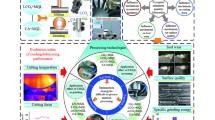Abstract
As the demand for difficult-to-cut materials (such as titanium alloys, nickel-based alloys, and stainless steels) continues to increase, internally cooled cutting is receiving increasing attention and research due to lowering the temperature of the cutting zone and improving the quality of the machined surface. With the increase of spindle speed, cavitation problem that plagues the development of high-speed fluid machinery may also cause cavitation damage to internally cooled cutting tools. This paper aims to study cavitation in the process of high-speed milling with internal cooling. A cavitation experiment platform for high-speed milling with internal cooling was established. A cavitation experiment was performed on the platform during high-speed milling with internal cooling. In order to facilitate the observation of cavitation during high-speed milling with internal cooling, Al 6063 and C45 were used as the materials of the workpiece and the milling tool, respectively. The experimental results reveal that after the experiment, fish scale cavity pits and cavitation pinholes were formed on the flank face and some machined surfaces of the workpiece. At the same time, the mechanism of cavitation damage was also preliminarily analyzed. This study is beneficial for exploring the cavitation mechanism in future high-speed internally cooled cutting and guiding the rational use of internally cooled cutting.









Similar content being viewed by others
References
Muhammad B, Wan M, Feng J, Zhang W (2017) Dynamic damping of machining vibration: a review. Int J Adv Manuf Technol 89:2935–2952
Krishnaraj V, Samsudeensadham S, Sindhumathi R, Kuppan P (2014) A study on high speed end milling of titanium alloy. Procedia Eng 97:251–257
Zhu K, Zhang Y (2019) A generic tool wear model and its application to force modeling and wear monitoring in high speed milling. Mech Syst Signal Pr 115:147–161
Che Ghani S (2013) Design and analysis of the internally cooled smart cutting tools with the application to adaptive machining. Brunel University, London
Oezkaya E, Biermann D (2018) A new reverse engineering method to combine FEM and CFD simulation three-dimensional insight into the chipping zone during the drilling of Inconel with internal cooling. Mach Sci Technol 22:881–898
Uhlmann E, Riemer H, Schröter D, Sammler F, Richarz S (2017) Substitution of coolant by using a closed internally cooled milling tool. Procedia CIRP 61:553–557
Islam A, Mia M, Dhar N (2017) Effects of internal cooling by cryogenic on the machinability of hardened steel. Int J Adv Manuf Technol 90:11–20
Li T, Wu T, Ding X, Chen H, Wang L (2017) Design of an internally cooled turning tool based on topology optimization and CFD simulation. Int J Adv Manuf Technol 91:1327–1337
Fallenstein F, Aurich J (2014) CFD based investigation on internal cooling of twist drills. Procedia CIRP 14:293–298
Wu Z, Yang Y, Su C, Cai X, Luo C (2017) Development and prospect of cooling technology for dry cutting tools. Int J Adv Manuf Technol 88:1567–1577
Brennen C (2013) Cavitation and bubble dynamics. Cambridge University Press, Cambridge
Kozák J, Rudolf P, Hudec M, Štefan D, Forman M (2019) Numerical and experimental investigation of the cavitating flow within Venturi tube[J]. ASME. J Fluids Eng 141(4):041101. https://doi.org/10.1115/1.4041729
Mathew M, Srinivasa Pai P, Pourzal R, Fischer A, Wimmer MA (2009) Significance of tribocorrosion in biomedical applications: overview and current status. Adv Tribol 2009:250986. https://doi.org/10.1155/2009/250986
Wang Y, Huang C, Du T, Fang X, Liang N (2012) Mechanism analysis about cavitation collapse load of underwater vehicles in a vertical launching process. Chin J Theor Appl Mech 44:39–48 (in Chinese)
Huang B, Wu Q, Wang G (2018) Progress and prospects of investigation into unsteady cavitating flows. J Drain Irrig Mach Eng (JDIME) 36:1–14 (in Chinese)
Arndt R (2002) Cavitation in vortical flows. Annu Rev Fluid Mech 34:143–175
Zima P, Furst T, Sedlar M, Komarek M, Huzlik R (2016) Determination of frequencies of oscillations of cloud cavitation on a 2-D hydrofoil from high-speed camera observations. J Hydrodyn 28:369–378
Qiu N, Wang L, Wu S, Likhacheva D (2015) Research on cavitation erosion and wear resistance performance of coatings. Eng Fail Anal 55:208–223
Lapovok R, Molotnikov A, Levin Y, Bandaranayake A, Estrin Y (2012) Machining of coarse grained and ultra fine grained titanium. J Mater Sci 47(11):4589–4594
Ning J, Nguyen V, Liang S (2019) Analytical modeling of machining forces of ultra-fine-grained titanium. Int J Adv Manuf Technol 101(1–4):627–636
Ning J, Liang S (2019) Predictive modeling of machining temperatures with force–temperature correlation using cutting mechanics and constitutive relation. Materials 12(2):284
Ning J, Liang S (2019) A comparative study of analytical thermal models to predict the orthogonal cutting temperature of AISI 1045 steel. Int J Adv Manuf Technol 102(9–12):3109–3119
Ning J, Nguyen V, Huang Y, Hartwig K, Liang S (2019) Constitutive modeling of ultra-fine-grained titanium flow stress for machining temperature prediction. Bio-Design Manuf 2(3):153–160
Marques P, Exaltação Trevisan R (1998) An SEM-based method for the evaluation of the cavitation erosion behavior of materials. Mater Charact 41(5):193–200
Chmiel J (2006) Cavitation-corrosion wear phenomena on CuMnAl ship propeller blades after welding and casting repairs. Conference of the 2006 Problems of Corrosion and Corrosion Protection of Materials
Yin N, Tan G, Li G, Li X, Wen L (2017) Numerical simulation on internal cooling of cutting zone in high-speed end-milling based on fluent. J Donghua Univ (Nat Sci) 43(4):510–514 +524 (in Chinese)
Funding
The authors would like to acknowledge the financial support of the National Natural Science Foundation of China under Grant No. 51375099, the Science and Technology Innovation Project of the Department of Education of Guangdong Province under Grant No. 2017KTSCX086, and the scientific research start-up funds of Guangdong Ocean University under Grant No. E15168.
Author information
Authors and Affiliations
Corresponding author
Additional information
Publisher’s note
Springer Nature remains neutral with regard to jurisdictional claims in published maps and institutional affiliations.
Rights and permissions
About this article
Cite this article
Yin, N., Shen, C., Xu, H. et al. Experiment research on cavitation in high-speed milling with internal cooling. Int J Adv Manuf Technol 108, 2177–2185 (2020). https://doi.org/10.1007/s00170-020-05308-8
Received:
Accepted:
Published:
Issue Date:
DOI: https://doi.org/10.1007/s00170-020-05308-8



